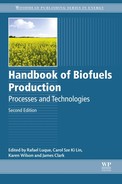10.2. Factors affecting the anaerobic digestion process
The microbial consortium in the AD process consists of several different microorganism groups which grow syntrophically or antagonistically, resulting in different responses to environmental changes. Therefore, when the activity of one of the microorganism groups is repressed, the growth of other microorganism groups is affected, the microbial population is changed, which may lower process efficiency or even cause a process failure. The main factors affecting the AD process are evaluated below.
10.2.1. Temperature
Temperature is one of the key parameters affecting the AD because it influences the microbial growth, enzymes activities, substrate characteristics, and consequently the methane yield. Although conventional AD is performed at mesophilic temperatures of 35–37°C (Forster-Carneiro et al., 2008), thermophilic AD has the advantages of higher specific growth rate, a faster metabolism, higher load-bearing capacity, and consequently results in a higher methane yield (Kim et al., 2011). Still, it should be noted that AD is affected negatively if the temperature is not constant. Compared to mesophilic AD, thermophilic AD is more sensitive to temperature change and it takes longer to adapt to a new temperature, as thermophilic methanogens have lower methanogenic diversity than mesophilic methanogens. Thermophilic AD has a higher risk of acidification, particularly when the biomass is rich in protein, which may consequently inhibit biogas production. This problem can be solved by the acclimatization of the inoculum. This problem can be solved by the acclimatization of the inoculum.
10.2.2. pH, free ammonia, and volatile fatty acids
Due to the complex composition of biomass, it is difficult to reach a steady state during AD. Methanogenesis occurs in the pH range of between 6 and 8.5 with an optimum pH range of 7.0–8.0. It is dramatically inhibited when the pH decreases below 6.0 or increases above 8.5. The imbalances in pH are created especially during the bioconversion of proteins and lipids, ie, by the accumulation of free ammonia and VFA. This in turn affects the functions of the extracellular enzymes and the hydrolysis rate. Nutrient-rich biomasses can be easily acidified into VFA by fermentative microorganisms. VFA accumulation results in a decrease in pH, and so might inhibit the methanogenic system.
On the other hand, excess of free ammonia can inhibit methane-synthesizing enzymes. Moreover, it might create proton imbalances and potassium deficiency, causing cell lysis. The inhibitory ammonia concentration to methanogenesis is still ambiguous. According to Mata-Alvarez (2003), inhibition takes place when total ammonia concentration is 1200 mg/L, while Hartmann and Ahring (2005) showed it begins at over 650 mg/L Angelidaki et al. (2005) reported that the efficiency of methanogenesis in large-scale AD plants codigesting manure and organic waste decreased when total ammonia was above 4000 mg/L in the digestate. Although it is demonstrated that high ammonia concentrations result in operational difficulties in digesters, it is also reported that microorganisms can adapt on higher free ammonia concentration with time. That is why it is difficult to foresee the precise ammonia concentration at which process failure or any instability may take place (Banks et al., 2011a; Forster-Carneiro et al., 2008).
In order to remove the excess ammonia, many different strategies such as ammonia stripping, biological nitrogen elimination processes, and electrochemical conversion can be employed (Ahn, 2006; Park et al., 2010; Walker et al., 2011). Although high free ammonia is a potential inhibitory factor, it might be desirable in some cases. It has been reported that digestion at high ammonia concentrations can provide stable biogas production by balancing the lowering pH caused by the accumulation of VFAs in continuous systems (Banks et al., 2011a).
10.2.3. Feedstock composition
Anaerobic microorganisms can metabolize different organic compounds (carbohydrates, proteins, lipids, etc.). The methane content of the biogas mixture depends on the biomass, particularly the oxidative state of carbon found in the feedstocks. The more reduced the carbon is, the higher the content of biogas in methane (Gujer and Zehnder, 1983). The C/N ratio of the feedstock should be well-balanced. A C/N ratio of 20–30 has been reported to be ideal for AD (Gomez et al., 2005). Unfortunately, in most cases the feedstock's C/N ratio is out of the range. In such a situation, the codigestion of selected feedstocks is often applied in order to adjust the C/N ratio and stabilize biogas production.
The lipid content of biomass also affects AD performance. High lipid content can also create problems during the digestion. Although the biomethane potential of the lipids (1014 L/kg VS) is much higher than carbohydrates (370 L/kg VS), long-chain fatty acids (LCFA) are inhibitory to the AD process and cause system failures at high concentrations. LCFA are absorbed on the cell surface and spoil cell transport mechanism. Furthermore, they are adsorbed on the biomass and cause microbial flocs (Zonta et al., 2013). The LCFA inhibition can be defeated by diluting its concentration via the addition of inoculum or by codigestion with lipid-poor feedstocks like cattle manure and sludge (Palatsi et al., 2009). The concept of codigestion has been discussed in detail in Section 10.5.2.
Macronutrients, such as phosphorus, potassium, magnesium, and sulfur are required for the activation and functioning of anaerobic microorganisms. Apart from macroelements, other trace elements are also crucial for cell growth and enzymatic activities. For example, nickel is crucial for coenzyme F430 synthesis, iron is an essential constituent of electron carriers, calcium stabilizes the cellular wall and is required for the thermal stability of the endospores, cobalt is the component of the vitamin B12, and zinc is required for the synthesis of several enzymes, etc. Still, they are toxic at elevated concentrations (Chen et al., 2008). To improve the AD performance, insufficient trace elements might be supplemented, while excess trace elements might be diluted by codigestion to prevent trace element inhibition (El-Mashad and Zhang, 2010; Zhang and Jahng, 2012).
..................Content has been hidden....................
You can't read the all page of ebook, please click here login for view all page.
